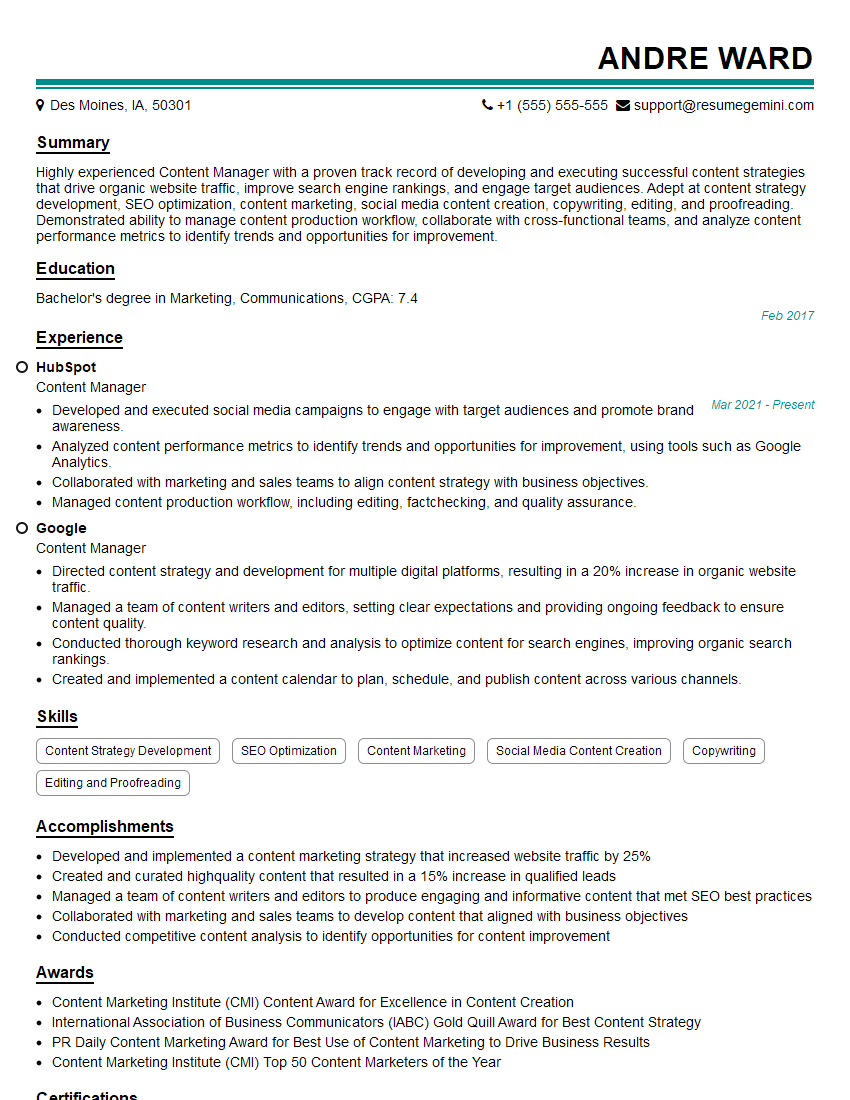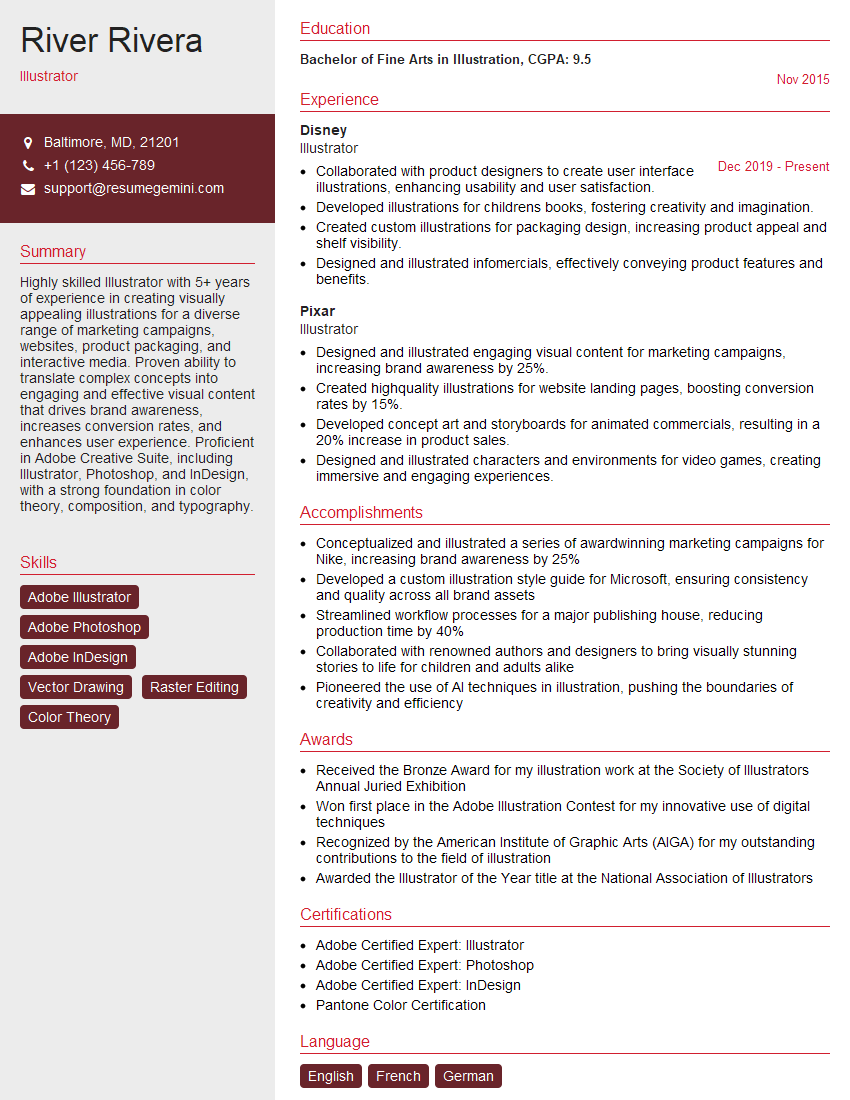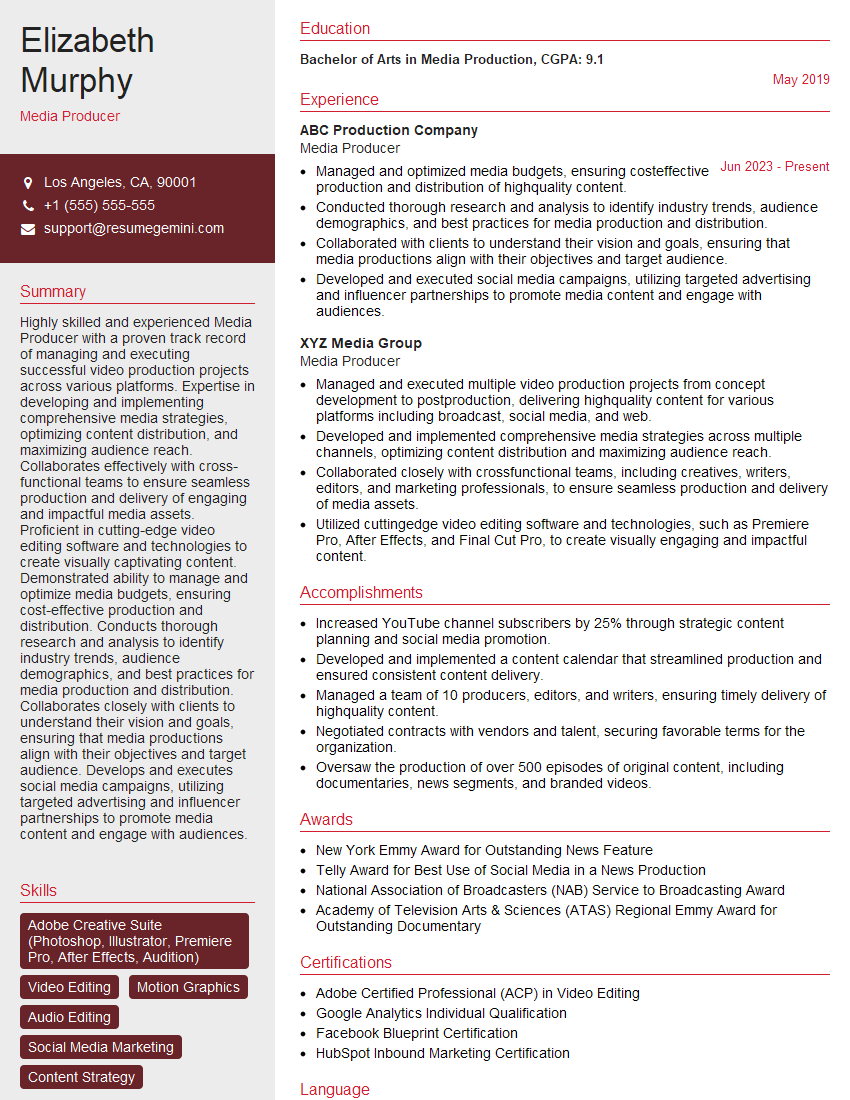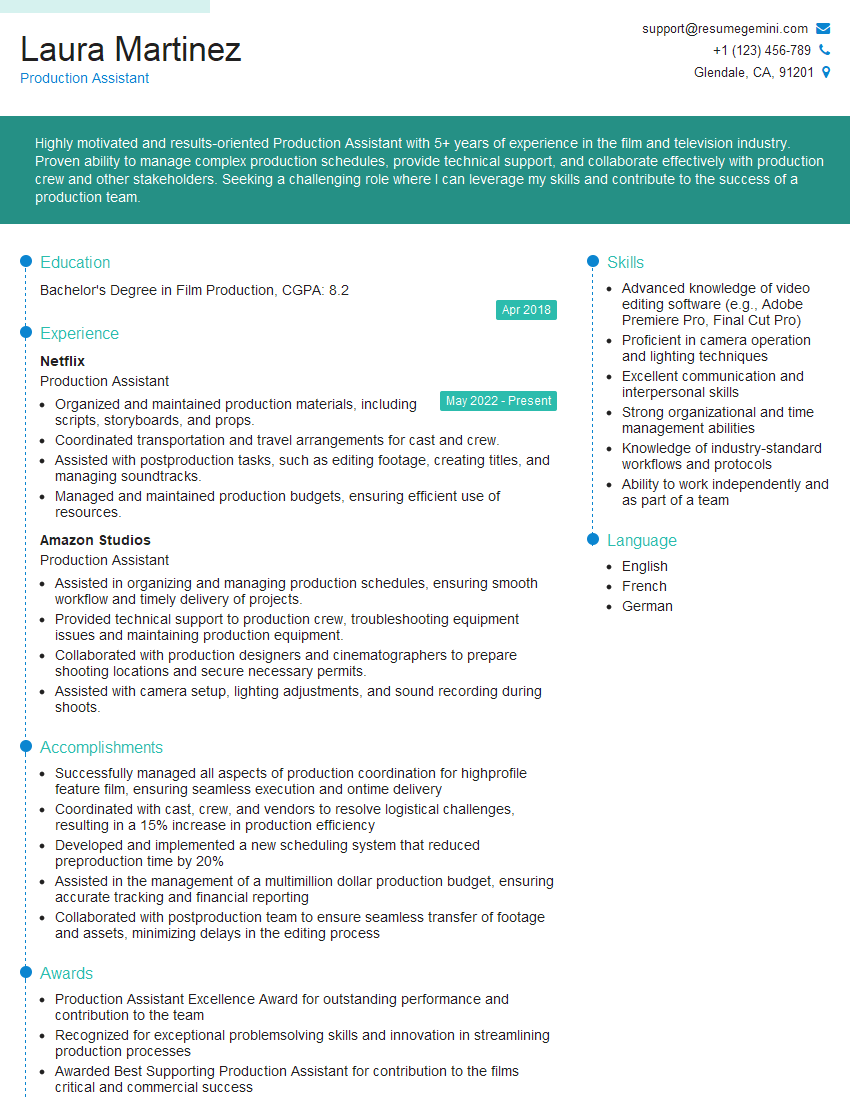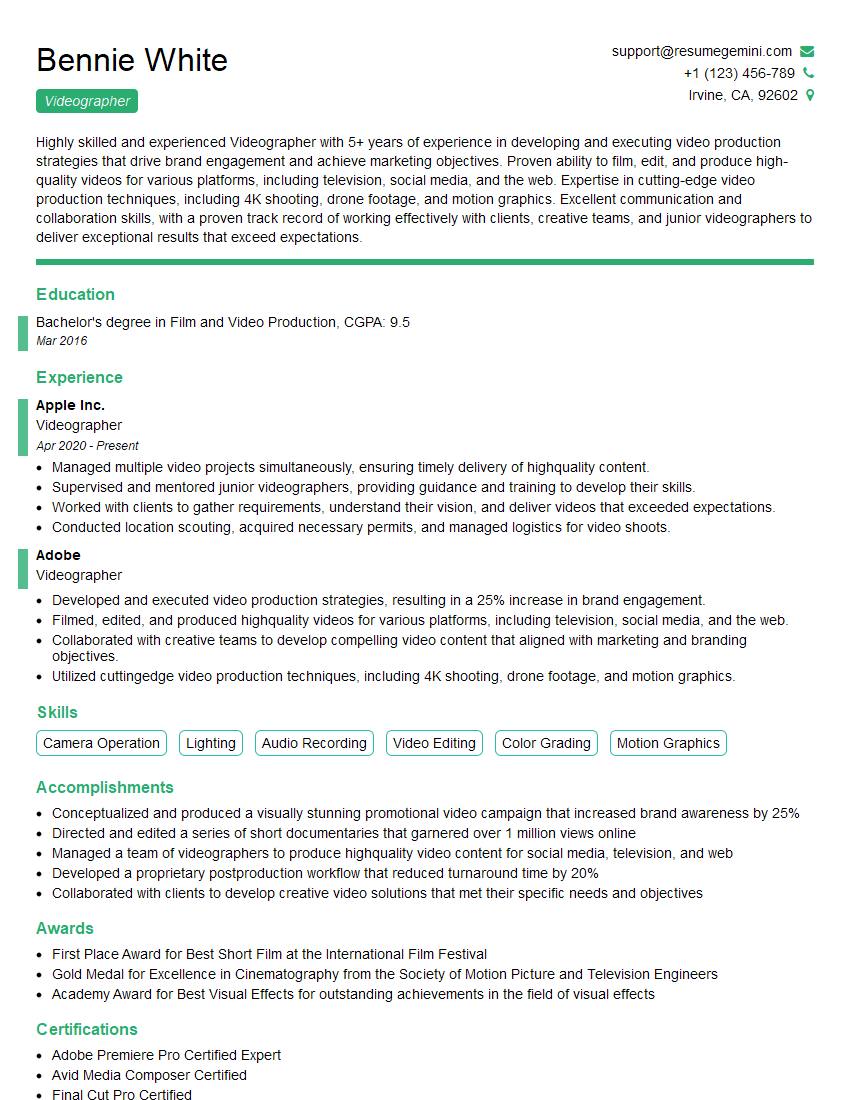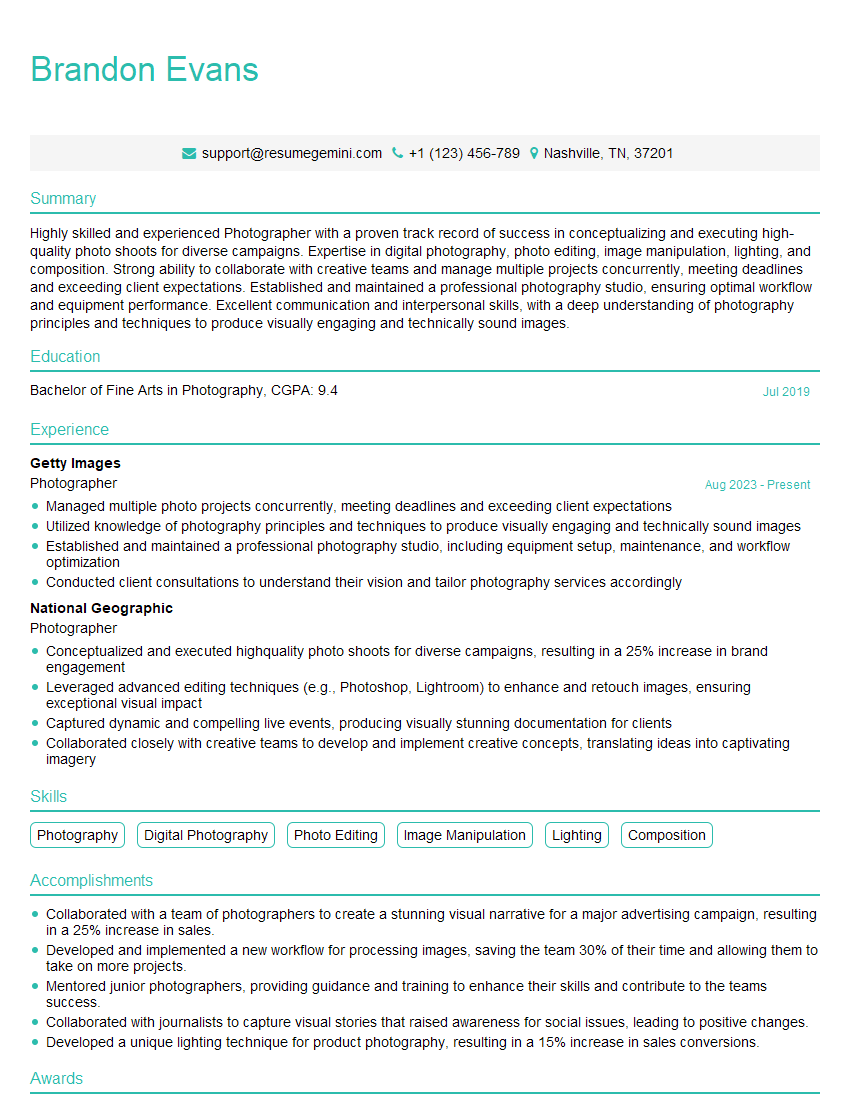Preparation is the key to success in any interview. In this post, we’ll explore crucial Media Production and Publishing Fundamentals interview questions and equip you with strategies to craft impactful answers. Whether you’re a beginner or a pro, these tips will elevate your preparation.
Questions Asked in Media Production and Publishing Fundamentals Interview
Q 1. Explain the difference between pre-production, production, and post-production in media.
Media production is broadly divided into three phases: pre-production, production, and post-production. Think of it like baking a cake. Pre-production is planning the recipe and gathering ingredients; production is the actual baking process; and post-production is the decorating and final presentation.
- Pre-production: This crucial stage involves planning and preparation. It includes scripting, storyboarding (visual representation of the script), casting (selecting actors), location scouting, budget allocation, scheduling, and securing necessary equipment and permits. For example, before filming a movie, the pre-production team would finalize the script, cast actors, secure locations, and design sets.
- Production: This is the actual filming or recording phase. In film, it’s when the cameras roll, actors perform, and the director guides the creative process. In audio production, this is when the music is recorded or the podcast is produced. During this stage, the team adheres to the pre-production plan and diligently captures footage or audio according to the established timeline and budget.
- Post-production: This phase involves editing, sound mixing, color correction (for video), visual effects (VFX), graphics, and the final mastering of the content. For a film, this is when the raw footage is assembled, sound is added, and special effects are implemented, all to create a polished final product. In a publishing context, this would be the final editing, typesetting, and proofreading of a manuscript.
Q 2. Describe your experience with various content management systems (CMS).
I have extensive experience with various CMS platforms, including WordPress, Drupal, and Contentful. My proficiency extends beyond basic content management; I understand database structures, template customization, plugin integration, and SEO optimization within these systems.
- WordPress: I’ve used WordPress extensively for building and managing websites, leveraging its plugin ecosystem for enhanced functionality (e.g., SEO plugins, e-commerce integration). I’m comfortable working with themes, customizing layouts, and ensuring responsiveness across different devices. For instance, I recently built a WordPress site for a small business that included a custom e-commerce solution using WooCommerce.
- Drupal: My Drupal experience includes developing and maintaining complex websites requiring advanced content structuring and workflow management. I’m familiar with Drupal’s robust API and its capabilities for handling large volumes of content. I used Drupal on a project managing a large-scale online encyclopedia with user-generated content.
- Contentful: I’ve utilized Contentful’s headless CMS approach for decoupled architecture projects. This experience has given me a solid understanding of APIs and how to integrate content seamlessly with front-end frameworks like React or Vue.js. A recent project leveraged Contentful for a mobile application to ensure content updates across multiple platforms could be managed efficiently.
Q 3. What are the key elements of a successful marketing campaign?
A successful marketing campaign hinges on a strategic blend of several key elements. It’s not just about advertising; it’s about understanding your audience and building a meaningful relationship.
- Clear Objectives: Defining measurable goals (e.g., increase brand awareness by 20%, generate 500 leads) provides a framework for evaluating success.
- Target Audience: Understanding your audience’s demographics, psychographics, and online behavior is critical for crafting targeted messaging and selecting appropriate channels.
- Compelling Messaging: The message should resonate with the target audience, highlighting the value proposition and benefits of your product or service.
- Strategic Channel Selection: Choosing the right platforms (social media, email marketing, search engine optimization, paid advertising) based on your audience’s preferences and campaign goals is crucial.
- Budget Allocation: Distributing resources effectively across various channels based on their potential ROI is essential for maximizing campaign impact.
- Measurement and Analysis: Tracking key metrics (website traffic, conversions, engagement) allows for ongoing optimization and assessment of campaign effectiveness.
For example, a successful campaign for a new fitness app might utilize social media influencers to reach a younger demographic, coupled with targeted Facebook ads and a strong email marketing strategy to nurture leads.
Q 4. How do you ensure brand consistency across different media platforms?
Maintaining brand consistency across platforms requires a structured approach and meticulous attention to detail. Imagine a symphony orchestra – each instrument plays its part, but the overall harmony depends on the conductor’s vision.
- Brand Guidelines: Developing comprehensive guidelines that cover visual elements (logo usage, color palettes, typography), voice and tone, and messaging ensures consistency. These guidelines serve as a bible for everyone involved in creating content.
- Style Guides: These guides ensure consistent writing style, grammar, and terminology across all platforms. They eliminate inconsistencies and improve readability.
- Centralized Content Management: Using a CMS or a central repository for all brand assets (images, videos, documents) ensures everyone accesses the same updated materials.
- Regular Audits: Periodically reviewing content across platforms helps identify inconsistencies and address them promptly. This proactive approach maintains uniformity and brand integrity.
For example, a company launching a new product might use the same color palette on its website, social media profiles, and print advertising, ensuring a unified brand experience for the customer.
Q 5. What are your preferred methods for editing text and video content?
My preferred methods for text and video editing are tailored to the specific task and desired outcome, prioritizing efficiency and quality.
- Text Editing: For text editing, I primarily use professional tools such as Adobe InDesign for layout and typography, Microsoft Word for general documents, and Google Docs for collaborative projects. I’m highly proficient in grammar, style, and proofreading, ensuring clarity and accuracy.
- Video Editing: I’m proficient in Adobe Premiere Pro and Final Cut Pro. My skills encompass video editing techniques like color correction, audio mixing, adding visual effects, motion graphics, and creating engaging narratives. I choose the platform based on project needs – Premiere Pro’s versatility is preferred for larger productions while Final Cut Pro’s user-friendliness is suitable for quicker edits.
Q 6. Explain your experience with different types of publishing (print, digital, online).
My experience encompasses various publishing formats – print, digital, and online – each demanding unique approaches and skill sets.
- Print Publishing: I’ve worked on various print projects, from brochures and magazines to books, gaining hands-on experience in pre-press preparation, print production management, and quality control. I understand the importance of high-resolution images, proper color profiles, and accurate file formats.
- Digital Publishing: I’m skilled in creating and distributing ebooks, interactive PDFs, and digital magazines using platforms such as Adobe Digital Editions and other relevant publishing software. Understanding file optimization for different devices and readers is crucial in this format.
- Online Publishing: My experience includes publishing content online through various CMS platforms (as discussed earlier), optimizing content for search engines (SEO), and managing online content updates. This includes creating engaging content formats like infographics and interactive elements to improve user experience.
For example, I recently managed the entire publishing process of a cookbook, from manuscript editing and design to print and digital distribution.
Q 7. Describe your experience with copyright and intellectual property laws.
I have a solid understanding of copyright and intellectual property (IP) laws and their implications in media production and publishing. I’m familiar with concepts like fair use, copyright infringement, trademarks, and licensing agreements.
- Copyright: I understand the importance of obtaining proper permissions for using copyrighted material, such as images, music, or text. I’m well-versed in the nuances of copyright laws and the implications of infringement.
- Fair Use: I can assess when using copyrighted material falls under the fair use doctrine, considering factors like the purpose and character of the use, the nature of the copyrighted work, the amount and substantiality of the portion used, and the effect on the potential market.
- Licensing: I understand different types of licenses (e.g., Creative Commons, royalty-free) and their implications. I can negotiate and implement appropriate licensing agreements to ensure legal compliance.
- Trademark: I understand the importance of protecting brand names and logos through trademark registration and ensuring their proper usage.
For example, on a recent documentary project, I ensured all music and footage usage was legally cleared through appropriate licensing agreements or fell under the guidelines of fair use. I have a strong emphasis on ethical and legal practices, and regularly consult with legal professionals when needed.
Q 8. How do you manage deadlines and prioritize tasks in a fast-paced environment?
In the fast-paced world of media production and publishing, effective deadline management is crucial. My approach relies on a combination of proactive planning and agile adaptation. I begin by breaking down large projects into smaller, manageable tasks, each with its own clearly defined deadline. This allows for better tracking of progress and easier identification of potential bottlenecks. I use tools like Gantt charts to visualize the project timeline and dependencies, ensuring a clear overview of the workflow. Prioritization is achieved using methods like the Eisenhower Matrix (urgent/important), focusing my energy on high-impact tasks that directly contribute to the project’s success. I also build in buffer time for unforeseen issues – think of it as insurance against unexpected delays. Regularly reviewing my schedule and proactively communicating with team members about potential conflicts ensures a smooth workflow and timely completion of projects.
For example, on a recent video production, I used a Gantt chart to schedule filming, editing, voiceover recording, and graphics creation. By allocating specific time slots and clearly outlining dependencies (e.g., editing can’t start before filming is complete), I ensured the project stayed on track.
Q 9. Explain your experience with project management software.
I have extensive experience with various project management software, including Asana, Trello, and Monday.com. My preference tends to lean towards Asana, due to its robust task management capabilities, team collaboration features, and integration with other essential tools like Google Calendar and Slack. I utilize these platforms to create project boards, assign tasks, set deadlines, track progress, and facilitate communication among team members. I find the ability to visualize the project workflow through kanban boards incredibly useful for monitoring progress and identifying potential roadblocks. The ability to attach files, leave comments, and have real-time updates ensures everyone is on the same page. For example, in a recent book publishing project, we used Asana to manage everything from manuscript revisions to cover design and marketing campaigns. This ensured transparency and accountability throughout the entire publishing process.
Q 10. Describe your experience with different file formats (e.g., JPEG, PNG, TIFF, MP4).
Understanding different file formats is fundamental in media production and publishing. Each format serves a specific purpose and has unique characteristics regarding image quality, file size, and compatibility. For example:
- JPEG (JPG): A lossy format ideal for photographs and images where slight compression is acceptable. It offers good compression ratios, resulting in smaller file sizes, making it suitable for web use.
- PNG: A lossless format ideal for images with sharp lines, text, and logos where preserving image quality is paramount. PNGs are larger than JPEGs but maintain better detail.
- TIFF: A lossless format frequently used in professional printing and archiving. It supports high resolution and color depth, making it ideal for high-quality images needing minimal compression.
- MP4: A versatile video format supporting various codecs, resolutions, and audio compression, making it suitable for online streaming and distribution.
Choosing the correct file format depends on the specific application. For web use, JPEGs and PNGs are common choices, while TIFFs are favored for print. Understanding these distinctions allows me to optimize file sizes for efficient storage and transfer without compromising visual quality.
Q 11. How do you ensure the quality of your work, both visually and editorially?
Ensuring high quality, both visually and editorially, is paramount. My quality control process is multi-faceted and involves several steps. Visually, I meticulously check for inconsistencies in color, lighting, resolution, and overall aesthetic appeal. I use calibrated monitors and color management software to ensure accurate color reproduction. I also regularly review work against style guides and brand guidelines to maintain consistency. Editorially, I meticulously proofread and edit all content, paying close attention to grammar, spelling, punctuation, and factual accuracy. I employ various techniques, like using a second reader for proofreading to catch errors I might miss. Using a style guide ensures consistency in formatting and voice, and for projects requiring more rigorous fact-checking I collaborate with subject matter experts to ensure accuracy. I believe that quality control is not an afterthought, but an integral part of the entire production workflow.
Q 12. What are some common challenges in media production and publishing, and how have you overcome them?
Media production and publishing present many challenges. One common hurdle is managing tight deadlines while maintaining quality. To overcome this, I use the project management strategies I previously discussed. Another challenge is dealing with unexpected technical issues, such as equipment malfunctions or software crashes. I mitigate this by having backup plans, maintaining redundant equipment where feasible, and having a thorough understanding of troubleshooting techniques. Client revisions and feedback can be another challenge, necessitating clear communication and iterative processes to ensure client satisfaction without derailing the project timeline. Finally, budgetary constraints often necessitate creative solutions to maximize resource utilization and achieve high-quality results within budget limitations. I address this by carefully planning budgets upfront, exploring cost-effective alternatives without compromising quality, and employing efficient workflow strategies.
Q 13. Describe your experience working with a team in a collaborative environment.
Collaboration is essential in media production and publishing. I thrive in team environments and value open communication, mutual respect, and shared responsibility. I’ve worked on numerous projects requiring seamless collaboration with writers, editors, designers, photographers, videographers, and developers. I actively foster a positive team dynamic through clear communication, regular check-ins, and constructive feedback. I believe in leading by example, actively contributing, and providing support to team members. For example, on a recent documentary film, I worked closely with the director, cinematographer, and editor, regularly discussing creative decisions, sharing feedback, and ensuring everyone was aligned with the project’s vision. Effective communication tools, such as project management software and instant messaging apps, proved invaluable in facilitating real-time collaboration and problem-solving.
Q 14. Explain your understanding of SEO best practices.
SEO (Search Engine Optimization) is crucial for increasing the visibility of media content online. My understanding encompasses keyword research, on-page optimization, and off-page optimization. Keyword research involves identifying relevant keywords and phrases that target audiences are likely to use when searching for related content. On-page optimization focuses on optimizing the website or content itself to improve its ranking in search engine results pages (SERPs). This includes optimizing title tags, meta descriptions, header tags (H1, H2, etc.), and image alt text, all incorporating relevant keywords. Off-page optimization involves building the website’s authority and credibility through techniques such as link building (earning links from other reputable websites) and social media promotion. Using analytics tools like Google Analytics helps track the effectiveness of SEO strategies and provides data-driven insights to make further improvements. For example, when publishing an article on a specific topic, I would conduct thorough keyword research to identify relevant terms. These terms would then be incorporated naturally into the article’s title, headings, and body text, further enhanced with high-quality images containing appropriate alt text. Finally, promoting the article on social media platforms would aid in increasing its visibility and earning backlinks.
Q 15. How do you handle constructive criticism and feedback?
Constructive criticism is invaluable for growth in media production and publishing. I approach it as an opportunity for learning and improvement. My process involves actively listening to the feedback, asking clarifying questions to fully understand the perspective, and then analyzing how the suggestions can enhance the project. I focus on separating the message from the messenger, understanding the intent behind the feedback rather than taking it personally. For instance, if a client suggests a different color palette for a marketing campaign, I’d investigate if the suggestion aligns with the target audience and brand guidelines. If it does, I’d gladly incorporate it, viewing it as a valuable improvement. I document all feedback, and I use it to refine my processes and future projects. I believe a collaborative approach, where open dialogue is encouraged, is key to successfully incorporating feedback.
Career Expert Tips:
- Ace those interviews! Prepare effectively by reviewing the Top 50 Most Common Interview Questions on ResumeGemini.
- Navigate your job search with confidence! Explore a wide range of Career Tips on ResumeGemini. Learn about common challenges and recommendations to overcome them.
- Craft the perfect resume! Master the Art of Resume Writing with ResumeGemini’s guide. Showcase your unique qualifications and achievements effectively.
- Don’t miss out on holiday savings! Build your dream resume with ResumeGemini’s ATS optimized templates.
Q 16. What are your strengths and weaknesses in relation to media production and publishing?
My strengths lie in my comprehensive understanding of the entire media production and publishing pipeline, from concept development to final distribution. I’m adept at project management, ensuring projects are delivered on time and within budget. I possess strong visual communication skills, with proficiency in various design software (detailed in a later response). My creative problem-solving skills allow me to find innovative solutions to complex challenges. A recent example involves adapting a print campaign to a visually engaging digital format, increasing our reach by over 30%. However, like everyone, I have areas for improvement. One weakness is my delegation skills, particularly in managing larger teams. To address this, I’ve enrolled in a project management course focused on leadership and delegation techniques.
Q 17. Describe your experience with social media marketing and content strategy.
My experience with social media marketing and content strategy is extensive. I’ve successfully managed social media campaigns for various clients, utilizing platforms like Instagram, Facebook, Twitter, and LinkedIn. My approach involves defining clear goals, identifying the target audience, creating a content calendar aligned with the brand voice, and using analytics to measure campaign effectiveness. For example, I developed a social media strategy for a local bookstore that resulted in a 25% increase in foot traffic within three months by using targeted advertising and engaging content such as author interviews and book reviews. I also understand the importance of creating visually appealing and shareable content that resonates with the audience. This involves understanding the different algorithms of each platform and optimizing content for maximum reach. Moreover, I’m well-versed in using tools for social media scheduling and analytics.
Q 18. How do you stay current with industry trends and technologies?
Staying current in this rapidly evolving industry is crucial. I actively engage in several strategies to stay updated. I subscribe to industry publications like Communication Arts and Print magazine, attend relevant conferences and webinars, and participate in online communities and forums focused on media production and publishing. I also follow key influencers and industry leaders on social media platforms. Moreover, I consistently experiment with new technologies and software, participating in online tutorials and courses to expand my knowledge. For example, I recently completed a course on immersive storytelling using virtual reality, recognizing its increasing significance in the industry.
Q 19. Explain your experience with different design software (e.g., Adobe Creative Suite).
I’m highly proficient in Adobe Creative Suite, specifically Photoshop, Illustrator, InDesign, and After Effects. I use Photoshop for image manipulation, retouching, and creating digital assets. Illustrator is my go-to tool for vector graphics, logo design, and illustrations. InDesign is essential for layout and design of print and digital publications. Finally, After Effects is used for motion graphics and video editing. I’ve utilized these tools extensively throughout my career, designing marketing materials, creating website layouts, and producing videos for various clients. I’m also familiar with other design software such as Figma and Canva, adapting my approach based on the project’s specific requirements.
Q 20. How do you measure the success of a media production or publishing project?
Measuring the success of a media production or publishing project depends heavily on the defined objectives. Key Performance Indicators (KPIs) vary based on the project’s goals. For a marketing campaign, we might measure success through metrics such as website traffic, lead generation, sales conversions, and social media engagement. For a publication, metrics may include readership numbers, website visits, ad revenue, and subscription rates. In every case, establishing clear, measurable, achievable, relevant, and time-bound (SMART) goals at the outset is crucial. Analyzing data gathered throughout the project and after its completion is essential for evaluating effectiveness and identifying areas for improvement in future projects. A/B testing and user feedback are also valuable tools in this process.
Q 21. What are your salary expectations?
My salary expectations are commensurate with my experience and skills in the industry. Based on my background and the specific requirements of the role, I’m open to discussing a competitive salary range.
Q 22. What are your long-term career goals?
My long-term career goal is to become a leading figure in the media production and publishing industry, specializing in innovative storytelling and content creation across multiple platforms. I envision myself leading teams to develop high-impact projects that blend traditional publishing strengths with cutting-edge digital media strategies. This includes mentoring junior professionals and pushing the boundaries of what’s possible in terms of reaching diverse audiences and creating engaging content that resonates deeply. Ultimately, I want to contribute significantly to shaping the future of how stories are told and information is shared.
Q 23. Why are you interested in this position?
This position resonates deeply with my career aspirations. The opportunity to contribute to [Company Name]’s reputation for [mention specific company achievement or value, e.g., high-quality journalism, innovative digital content, commitment to diverse voices] is incredibly exciting. I’m particularly drawn to [mention specific aspects of the job description, e.g., the use of emerging technologies, the focus on a specific niche, the collaborative team environment]. My skills and experience in [mention relevant skills, e.g., project management, content creation, digital marketing] align perfectly with the requirements, and I’m confident I can make a significant contribution to the team’s success.
Q 24. Why are you leaving your current role?
I’m leaving my current role at [Previous Company Name] to pursue opportunities for professional growth and a more challenging and impactful environment. While I gained valuable experience in [mention specific skills gained], I’m seeking a position that allows me to utilize my full skill set in a more dynamic and innovative setting. [Company Name]’s reputation and the specific challenges of this role provide an ideal opportunity to reach my next level of professional development.
Q 25. Describe a time you had to make a difficult decision under pressure.
During my time at [Previous Company Name], we faced a significant delay in the launch of a major publication due to unforeseen technical issues with our digital platform. Under immense pressure to meet the deadline, I had to make the difficult decision to temporarily postpone the launch, despite the considerable marketing and financial investment already made. Instead of rushing a subpar product, I rallied the team to focus on resolving the technical problems efficiently. This involved prioritizing tasks, delegating effectively, and communicating transparently with stakeholders. Although it was a stressful time, the resulting successful launch, without compromising quality, proved the value of that difficult decision. This experience reinforced the importance of prioritizing quality over immediate deadlines in media production.
Q 26. Describe a time you had to solve a complex problem.
In a previous project, we encountered a complex problem when a key contributor unexpectedly left the team mid-production. This resulted in a significant gap in expertise and a potential delay in the project’s timeline. To solve this, I first assessed the remaining team members’ skills and identified which tasks could be reassigned effectively. Then, I utilized external resources, such as freelance writers and editors, to fill the remaining gaps, focusing on maintaining consistency in quality and style. Finally, I implemented a new project management system to improve communication and transparency across the team. Through this structured approach, we successfully completed the project on time and without compromising quality, highlighting the importance of resourcefulness, adaptability, and efficient project management in high-pressure situations.
Q 27. Describe a project you are particularly proud of and why.
I’m particularly proud of my work on [Project Name], a [Project Type, e.g., multimedia documentary, magazine series] that explored [Project Topic]. This project was challenging because of [mention specific challenges, e.g., limited budget, difficult subject matter, tight deadlines]. However, by utilizing innovative storytelling techniques, [mention techniques, e.g., interactive elements, compelling visuals, diverse voices], we created a product that exceeded expectations. The positive feedback we received from both critics and the audience, and the impact it had on [mention impact, e.g., raising awareness of a social issue, promoting positive change], makes me incredibly proud of the team’s collaborative efforts and the final result. This project exemplified the power of effective collaboration and creative problem-solving in media production.
Q 28. What is your preferred style guide, and why?
My preferred style guide is the Chicago Manual of Style. I find its comprehensive coverage of various writing, editing, and citation styles invaluable for creating high-quality, consistent content across diverse media. It provides clear and detailed guidance on everything from grammar and punctuation to bibliographic formatting and ensures accuracy and professionalism in all published materials. While other style guides exist (e.g., AP Stylebook, MLA), the Chicago Manual’s broad scope and emphasis on academic rigor make it ideal for the meticulous approach I take in my work, particularly in projects involving research and in-depth reporting.
Key Topics to Learn for Media Production and Publishing Fundamentals Interview
- Content Creation & Strategy: Understanding audience needs, developing content calendars, and crafting engaging narratives across various media (print, digital, video).
- Production Workflow & Project Management: Managing timelines, budgets, and teams; utilizing project management tools; understanding pre-production, production, and post-production phases.
- Digital Media & Publishing Platforms: Familiarity with CMS platforms (WordPress, etc.), social media strategies, SEO optimization, and digital asset management.
- Visual Communication & Design Principles: Understanding typography, layout, color theory, and image composition for effective visual storytelling.
- Media Ethics & Legal Considerations: Copyright law, fair use, responsible content creation, and ethical considerations in media production and publishing.
- Technical Proficiency: Demonstrating practical skills with relevant software (e.g., Adobe Creative Suite, video editing software) and hardware.
- Data Analysis & Reporting: Understanding key performance indicators (KPIs), analyzing data to inform content strategy, and presenting findings effectively.
- Adaptability & Innovation: Showcasing your ability to embrace new technologies and adapt to evolving media trends.
- Problem-Solving & Collaboration: Illustrating your ability to troubleshoot technical issues, work effectively in teams, and handle pressure in fast-paced environments.
Next Steps
Mastering Media Production and Publishing Fundamentals is crucial for career advancement in this dynamic field. A strong understanding of these core concepts will significantly enhance your job prospects and allow you to contribute effectively from day one. To maximize your chances of landing your dream role, creating a compelling and ATS-friendly resume is essential. ResumeGemini is a trusted resource to help you build a professional resume that highlights your skills and experience. We provide examples of resumes tailored to Media Production and Publishing Fundamentals to guide you through the process. Take advantage of these resources to showcase your capabilities and secure your desired position.
Explore more articles
Users Rating of Our Blogs
Share Your Experience
We value your feedback! Please rate our content and share your thoughts (optional).
What Readers Say About Our Blog
Hi, I’m Jay, we have a few potential clients that are interested in your services, thought you might be a good fit. I’d love to talk about the details, when do you have time to talk?
Best,
Jay
Founder | CEO





